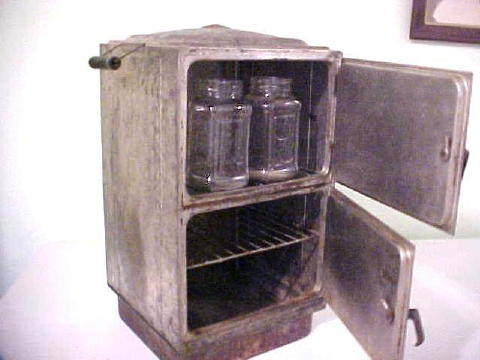
By Joy Stevens, Grantsville 2003
If there was anything my mother despised more than dirt it was a hot, steamy
kitchen during summer canning season. Her dreams came true when my father, who
loved her very much, brought her a "Conservo."
This was during the depression in the late 1920's. It probably cost him $12 and there
were few households in the community who could afford this modern
canner-cooker.
I do know that a testimonial to the Conservo by Mrs. Ora Stephen of Slate, West
Virginia, who told of being in the F. A. Sthalman's Store of Parkersburg and buying
the device.
The Conservo was produced by the Swartzbaugh Manufacturing Company. I do not
know when it was patented. I do know that it was a blessing over the wash boilers
and tubs used for canning vegetables and meats at that time.
For those fortunate enough to own a Conservo, it was loaned to neighbors during
busy canning periods for it allowed unbelievable speed-up in canning time. My
mother's Conservo and dream ended when she misjudged and "loaned" her
Conservo to a dishonest neighbor.
The steam canner was made of heavy tin and was without a doubt the simplest
outfit for home canning, then and now. It was designed to fit over one single burner
of any type of range, gas, oil, coal or wood. The copper bottom held several quarts of
water to provide steam. It was so well insulated that only the slightest heat escaped
into the kitchen.
The time for steam canning was the same as that used for wash boiler or cold-pack
canning. The steam from the boiling water in the tank permeated and thoroughly
cooked, by steam pressure, the food placed on the shelves.
A tube was inserted through the hole in the upper corner ot the Conservo from the
outside, and a whistle indicated when water was needed. One commenced counting
the canning time when water started to boil. If steam escaped, it meant the cook
was firing up more than needed.
For cooking meals, potatoes with jackets or corn-on-the-cob, the items were placed
directly on the shelves, or on top of canning jars, in case you were doing both at
once. Two compartments, one above the other, held sixteen quart jars, or by using
the two racks, thirty-two pint jars. Imagine!
The Conservo manufacturer warned users not to use preservatives with this type of
canning. They said all "jarred" foods should be cooked a minimum of 10 minutes
before serving. My mother never lost a jar to spoilage.
Even fish, first browned and then placed in jars with drippings added, could be
processed three hours under steam pressure.
Mrs. George Daman of Cresco, Iowa, wrote "How I Take Care of a Whole Hog With My
Conservo." She said "The men butcher one hog one day, let it cool over night, and I
plan to have it out of the way by the next day. They usually dress 100 to 175
pounds."
"I arise early in the morning (the men have split the hog). I lay it on a table, cut off
the head, peal out leaf lard, cut off shoulders and hams, skin out ribs, cut the rest
into bellies and back."
"The bellies I put in brine for immediate use, beans, etc. The back I cut in slices and
fry just part done or until slightly brown, pack in sterilized jars and cook 90 minutes.
The other ham and shoulder I cut into small pieces, pack in jars raw, add one
teaspoon of salt to each quart jar. The raw meat is processed in the Conservo for
three hours, all partly cooked meats for 90 minutes.
"I take the legs with feet cut off, bones, heart and tongue, put them in a large kettle,
salt and boil until tender. When it is cool enough, I remove the meat from the bones
and pack it in jars and put some stock over it. This makes excellent meat ground for
sandwiches. I cut the heart and tongue in slices, pack in pint jars, pour vinegar with
a little stock and sugar over it. I also fix part of the pigs feet this way. I also can all
the extra stock from the boiled meat and roast meat for gravies.
"I slice the liver and roll in flour, pertly fry and pack in pint jars, pour liquid over and
process for 90 minutes. I trim the head and use any extra meat scraps for sausage,
which I make into patties, partly fry, pack in quart jars and process 90 minutes.
"Then comes the lard. I put it through the food grinder and fry out in the oven while
using the top of the stove for the Conservo. I strain and pour into quart or half-gallon
jars and seal while hot. This does not have to be processed."
She goes on to tell about cooking hams, shoulder and wild meat in the Conservo.
Keeping church dinners warm was another way to use the device, carrying the
whole meal to functions.
The Conservo was well-built, no parts to get lost or broken - and easy to clean, a
boom to a housewife in a small kitchen. Every test given the device gave it high
claims, and it gained a national reputation.
I say God bless the inventor of the Conservo, and hopefully some alert aluminum
company will investigate whether the patent is pending and consider manufacturing
the device again.
The savings in the price of gas or electric in being able to can 16 quarts of
vegetables or meats over one burner is extraordinary.
(Stevens Is Now Deceased)
| 


